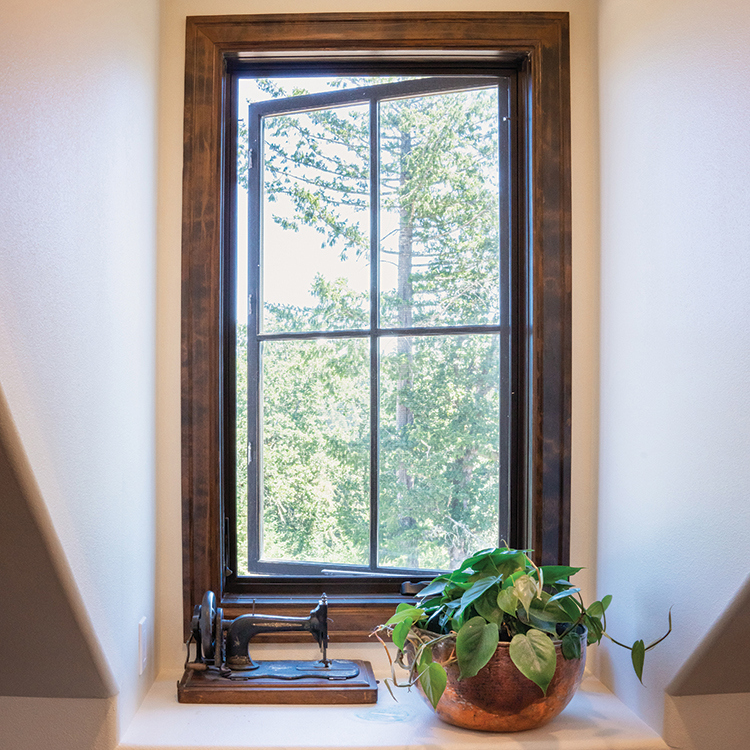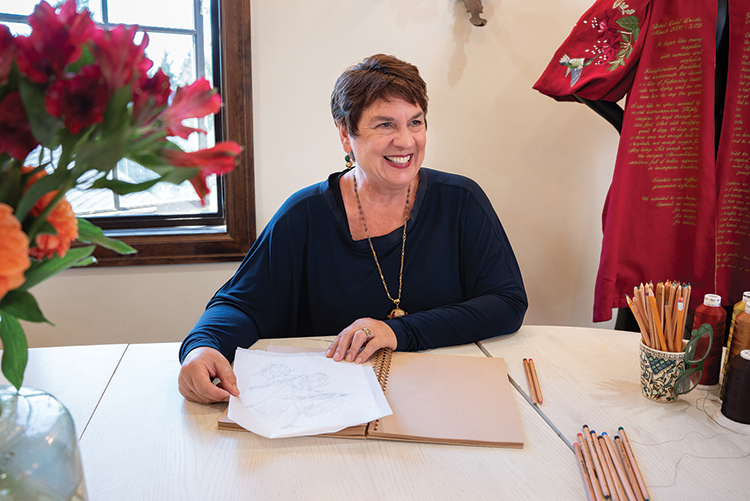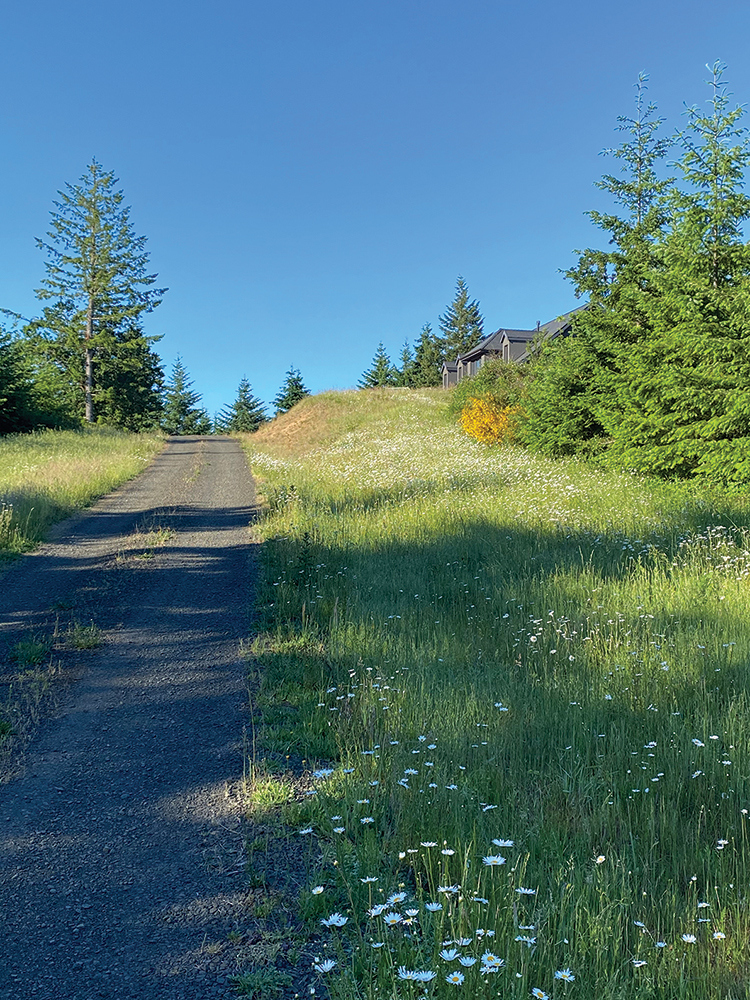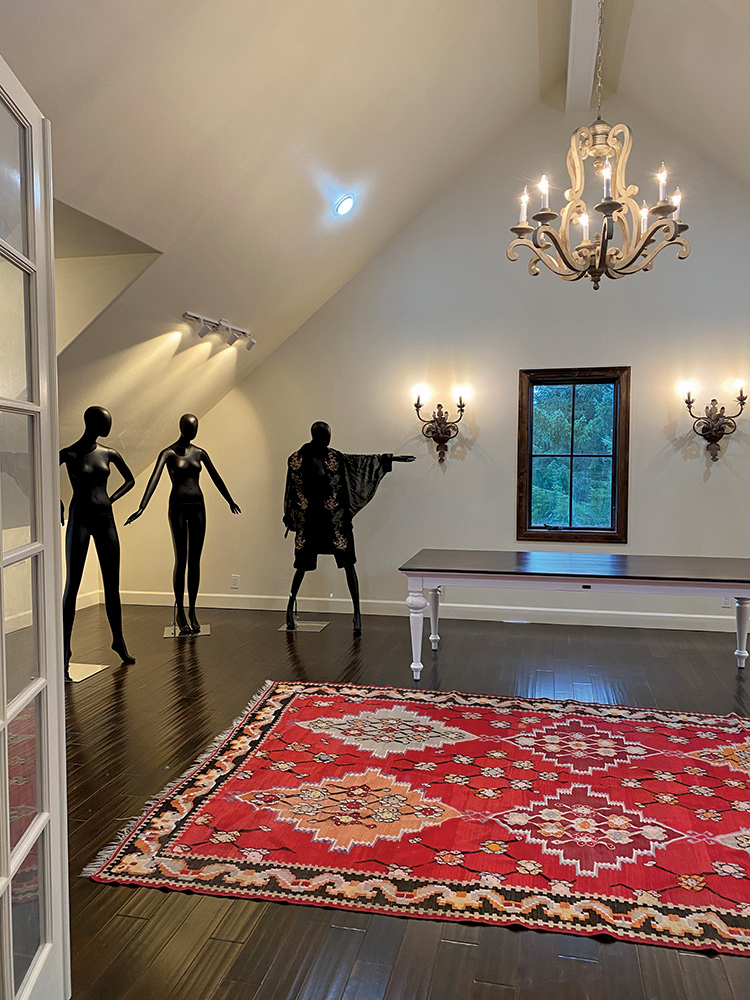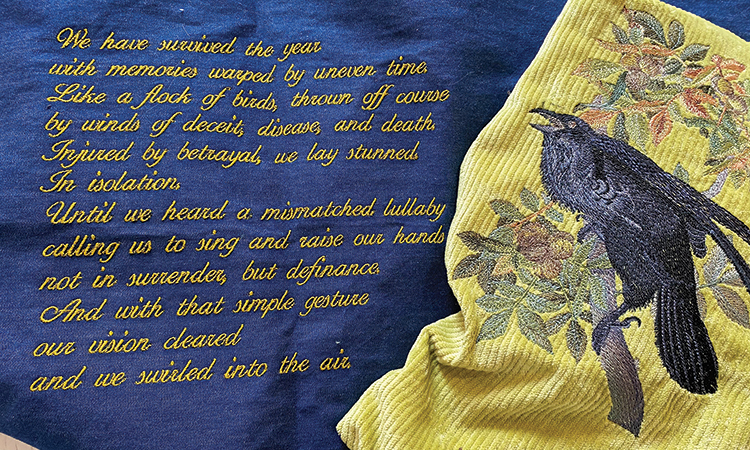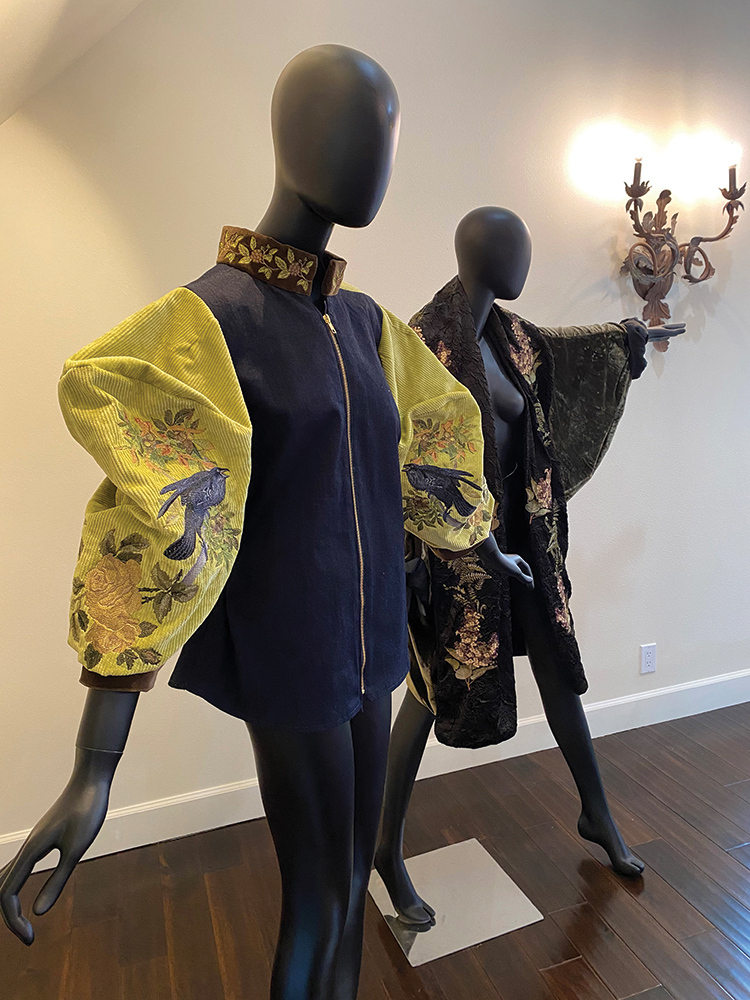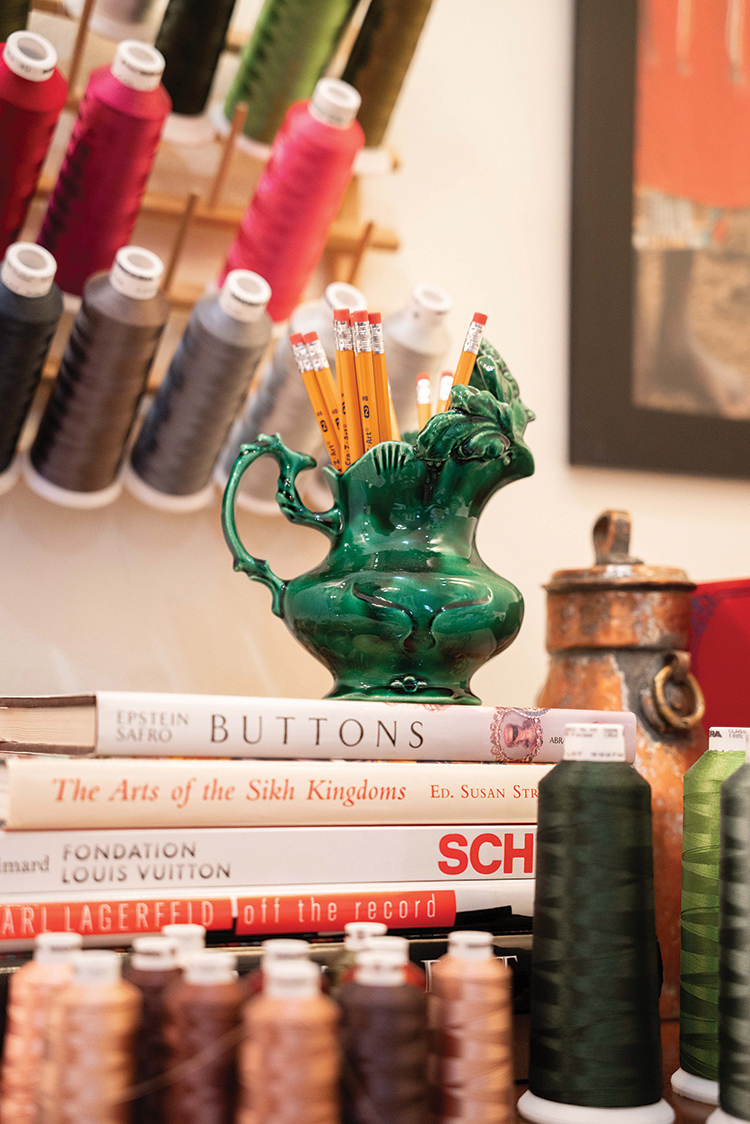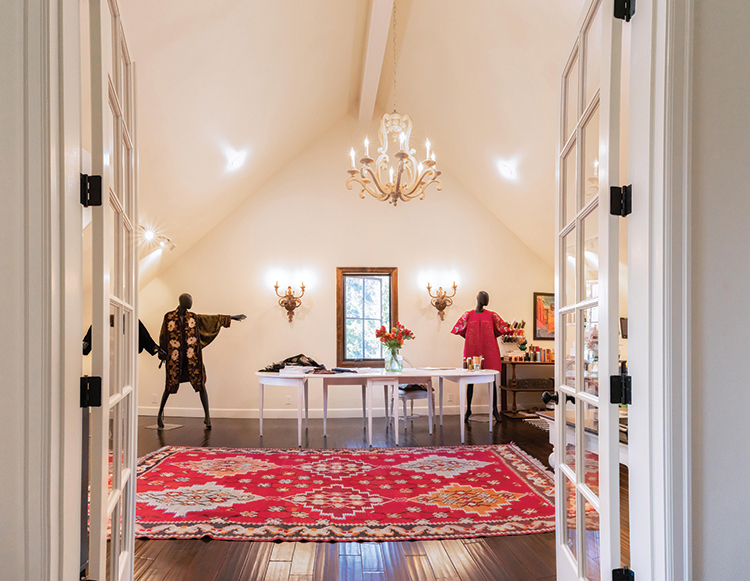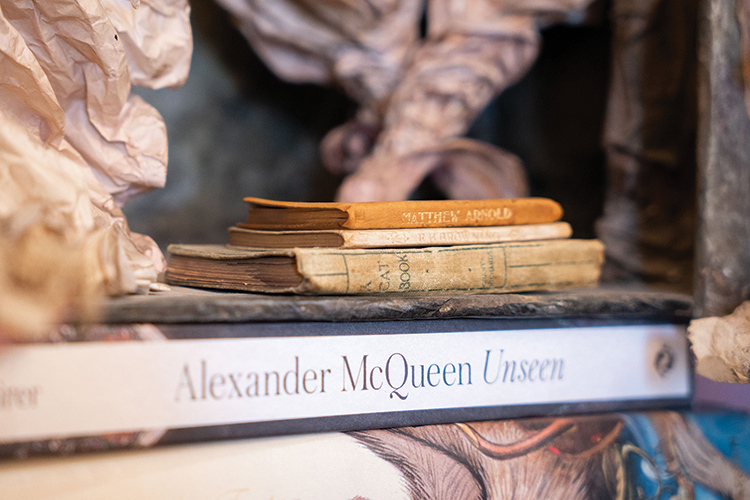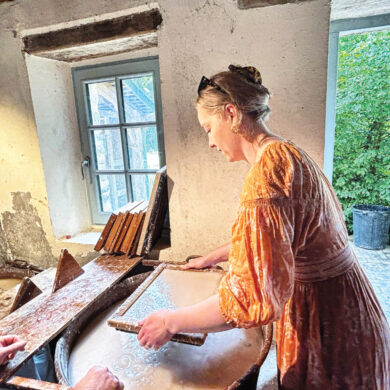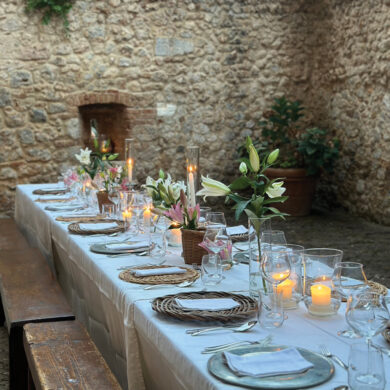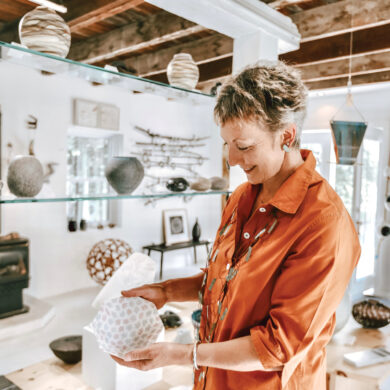I’m sitting in my chair near the western window, listening to the soft rainfall and finishing the handwork on my latest story coat. This last stage of a project tends to make me a bit anxious; is the story right? Are there imperfections? Will it hang comfortably? All the doubts a creative has assail me at this point of completion—this point where I’m about to let go and the idea becomes a garment, no longer just a process. The soft swish of the gentle rain soothes me and, after checking on the current in-progress embroidery, I take time to look around the room.
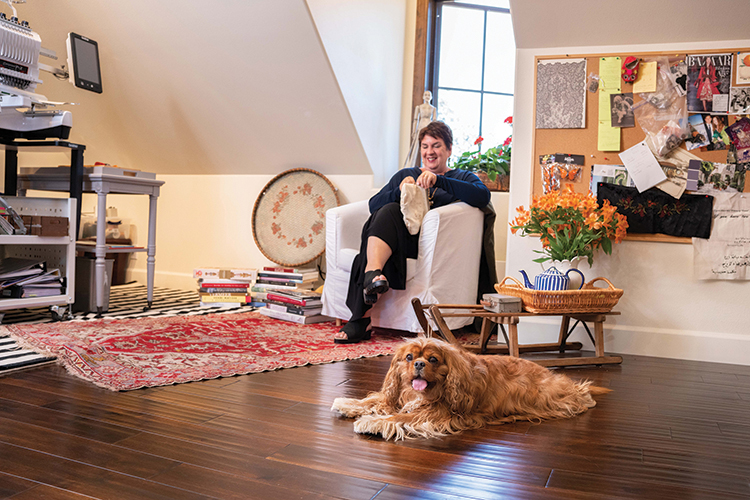
This studio is a new chapter for me, and I’m completing my first full range of seasons in this new place. For many years, I’ve been living and working internationally (Uganda, Mauritius, Philippines, United Arab Emirates, Turkey, England, Germany, France). A willing nomad, I also longed for a non-transient home. Last year, we made the leap and settled into a house I designed—a lush spot of land in rural Oregon we chose first from a list of “must haves”, but ultimately for the feeling my husband, daughter, and I had when we walked up this hill. When I designed the house, I wanted it to snuggle into this hill, I wanted the rooms to be cozy, I wanted big windows to let in the light and bear witness to the incredible Pacific Northwest storms that stream through the canyon.
From my studio on the second floor, I have windows facing all four compass points: eastern early morning sunrise, afternoon quiet to the south (just me, the deer, some crickets, and a mischievous squirrel), the cool northern side, and the velvety green western coast range. I find my tasks move me around the room as the day progresses: morning for sewing work when the eastern light (and my eyes) is at its strongest, mid-day to the southern long worktable for design layouts, afternoon to the cool north for computer embroidery digitizing or writing, and evening to this western work chair to catch the late afternoon sun.
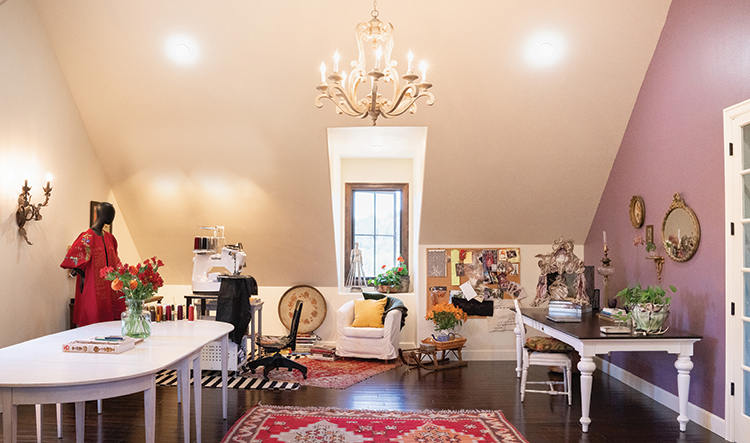
While I move around the room, the embroidery machine is chattering and the birds outside are chirping. My little furry friend follows me around the room, sometimes reminding me to take a tea break (and for her a biscuit break). My breaks usually take me through my cozy kitchen for a short wander around the yard. This leads me to daydream about the garden I will one day create: right now, our “garden” is a mix of construction dirt, wild grasses and wildflowers. And strangely, with my “get things done and dusted” approach, I find the dirt and wildflowers enough. For once in my life, I have the gift of permanence, and there is time to let things unfold.
I’ve built a walk-in closet that holds my array of fabrics and trims I’ve collected throughout my travels. Antique Indian blankets, vintage tablecloths, luscious velvets, French cottons, Philippine rice cloth, Cambodian needlework, Jordanian handwork, all waiting to inspire me and be molded into something even more lovely and beautiful. I must keep these beauties away from my eyes while I’m on a project, or like a Bower Bird, I’ll get distracted and be off on a new tangent! A pile of poetry books sits on the sideboard, all vying for their words to be shared in a textile-sort of way.
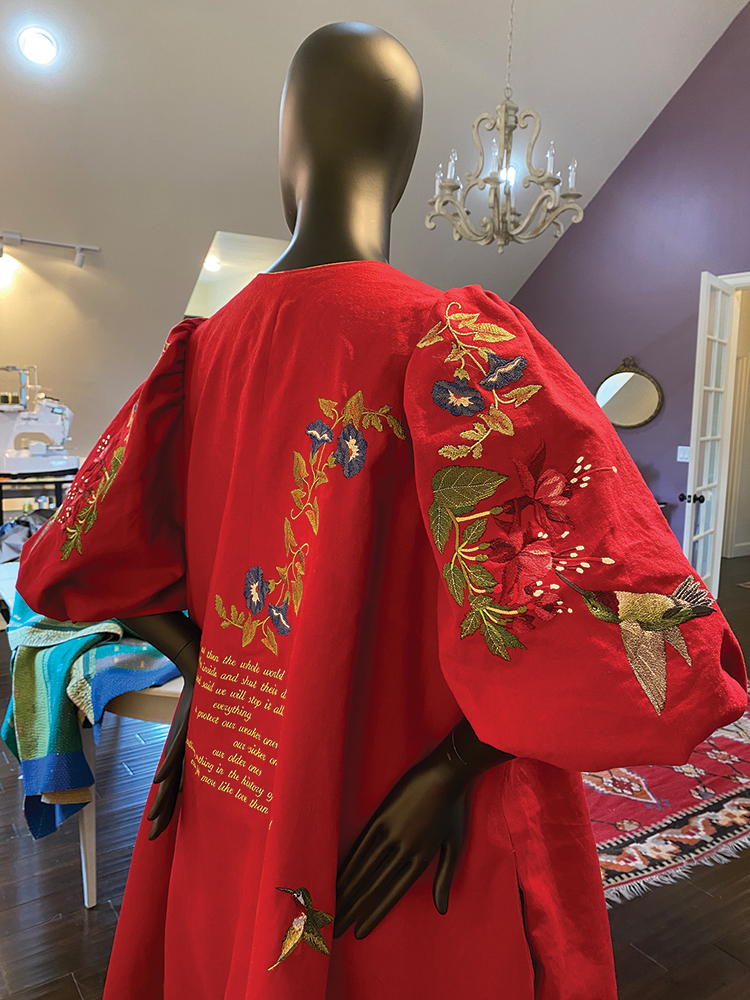
In addition to the adventures with my husband, I grew up in a military family. Much of my life was spent moving, with part of my heart left in each far-off home. My studio is a memory chest of my life: the antique kilim a gift to my father from one of his Turkish friends, the sideboard found at a “penny sale” my mother and I sought out when we lived in England, the “table” beside my chair is a sleigh from Germany, a vase from a business trip to southern France. Each piece holds a memory: a day out with a friend, an enthusiastic taxi driver, a quiet day to myself exploring a market.
The magazine article on the bulletin board is a note from my mother when I first began making coats (she, of course, thought my coats were much better than that of the designer in said article!). She has passed on now, but this little reminder inspires me to trust my instincts and assures me that I have always been loved. Along with the exotica, there’s evidence of my new life: a Pacific Northwest bird chart, a dahlia planting guide, a list of day outings in Oregon, snapshots of my children and grandchildren.
It’s a privilege to travel, and an even greater one to stop long enough to make lifelong friendships. My heart has found a home in many lands, and my story coats emerged from my need to treasure the many stories I’ve heard or remembered from these journeys. They are authentic whispers of my experiences and the lovely people I’ve met along the way. They are sometimes outraged cries of injustices witnessed, sometimes a soft whisper of a kindness. The embroidered images enhance the tales. So many stories to tell, and now a permanent place to slowly unravel the memories.
At day’s end, the hand sewing done, I gaze at my inspiration board. It’s full of pictures, fabric swatches, buttons, poems, a haiku on a scrap of paper. I consider my options; the current project has been a tough emotional subject, and I have a coat about death underway, so I think I want something a little lighter from my trove of memories. I find myself leaning on the window ledge watching the swallows arrive with little mouths full of mud and swirl away, chittering, toward the creek.
I look back across the room at the board and think about the haiku: it says something about soaring heavenward. Then I think about the antique blankets and their vibrant colors. A short, padded jacket embroidered with the swallow’s image and a sweet haiku might be just the thing to honor their industrious behavior. They flew so far to find this spot, and I’m so grateful our paths are crossing.
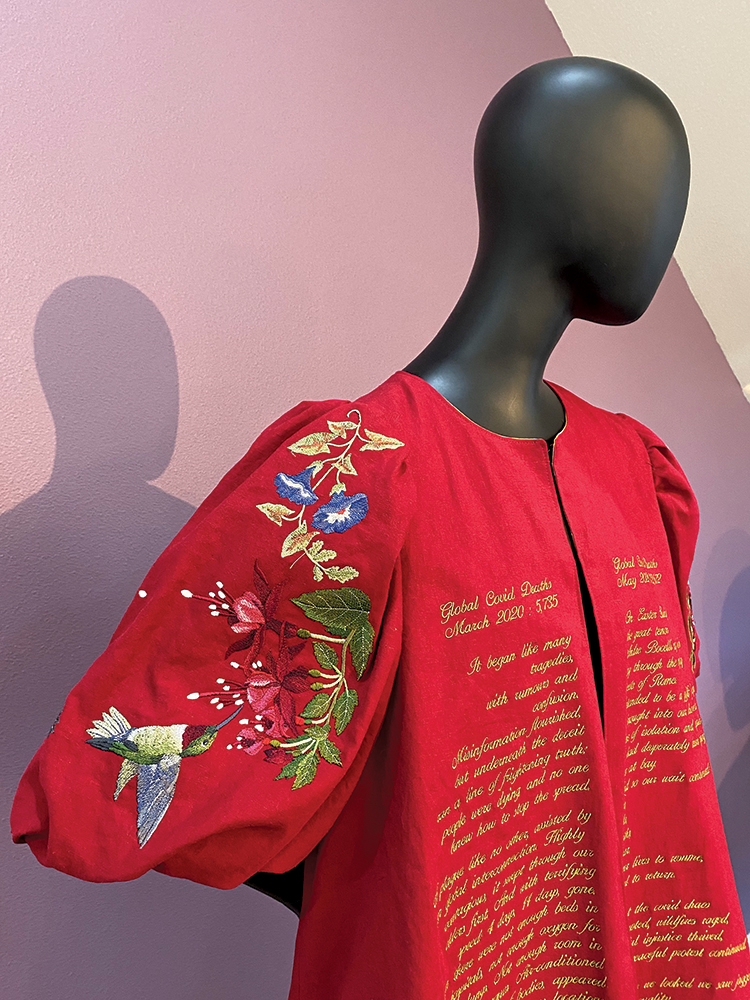
“And now let us welcome the full of things that have never been.”
— Rainer Maria Rilke
Story of the Hummingbird Coat
My coats tell stories of memories, events, impressions. This Hummingbird Coat is a reflection of the Covid-19 pandemic year. A year that was filled with emotion: fear, unease, confusion. It was also filled with moments of clarity and hope, which is why I chose a bright red and embellished the sad story with joyful flowers and energetic hummingbirds. The interior lining is African fabric I purchased at a lake-side market in Uganda—a market full of cheerful women who had canoed across Lake Victoria to bring their goods to market. I felt lining the coat with a fabric that, in my mind, represents women of strength would perhaps pass some of that strength and character on to the wearer of my coat; a reminder that even at our lowest, we are not alone, but part of a global story.
This poem is written on the back of the red coat and was widely circulated on Instagram in 2020. It captured the love and generosity I witnessed throughout the year.
And then the whole world
walked inside and shut their doors.
And said we will stop it all,
everything.
To protect our weaker ones,
our sicker ones,
our older ones.
And nothing, nothing, in the history of humankind
ever felt more like love than this.
—C.D.
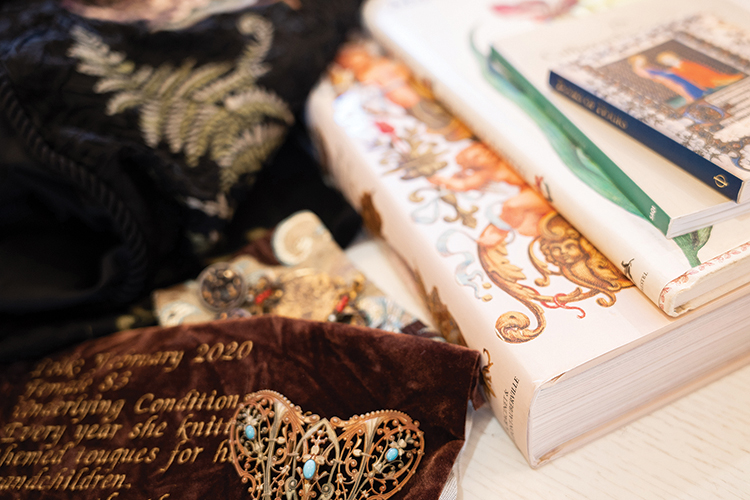
The complete story that is embroidered on the red coat:
Global Covid Deaths
March 2020: 5,785
It began like many tragedies,
with rumors and confusion.
Misinformation flourished,
but underneath the deceit ran a line of frightening truth:
people were dying, and no one knew how to stop the spread.
A plague like no other, assisted by our global connection. Highly contagious, it
swept through our elders first. And with terrifying speed: 4 days, 14 days, gone.
Soon there were not enough beds in the hospitals, not enough oxygen for struggling lungs.
Not enough room in the morgues. Air-conditioned containers,
full of bodies, appeared in incongruous locations.
Scientists were baffled.
Governments ineffectual.
We retreated to our homes.
Stunned, we waited:
for answers,
for insight,
for solutions.
On Easter Sunday the great tenor Andrea Bocelli sang his way through the empty streets of Rome.
Intended to be a gift of hope, it brought into our homes a sense of isolation and despair
we had desperately been trying to keep at bay.
And so, our wait continued:
days,
weeks,
months,
a year,
for our lives to resume, normal to return.
Amidst the covid chaos
wars erupted, wildfires raged,
social injustice thrived,
peaceful protest continued.
Everywhere we looked we saw jagged lines of inequality, broken hearts, and fear.
But from our ennui of despair, a collective thought occurred,
as if all the thoughts in isolation began to see that
hearts can heal, distant hands can touch.
Perhaps our slower lives were not the problem,
But the solution?
Sighing, we pulled back from the cliff
To begin the work of our new reality.
Global Covid Deaths
May 2021: 3,432,672
I’m sitting in my chair near the western window, listening to the soft rainfall and finishing the handwork on my latest story coat. This last stage of a project tends to make me a bit anxious; is the story right? Are there imperfections? Will it hang comfortably? All the doubts a creative has assail me at this point of completion—this point where I’m about to let go and the idea becomes a garment, no longer just a process. The soft swish of the gentle rain soothes me and, after checking on the current in-progress embroidery, I take time to look around the room.

This studio is a new chapter for me, and I’m completing my first full range of seasons in this new place. For many years, I’ve been living and working internationally (Uganda, Mauritius, Philippines, United Arab Emirates, Turkey, England, Germany, France). A willing nomad, I also longed for a non-transient home. Last year, we made the leap and settled into a house I designed—a lush spot of land in rural Oregon we chose first from a list of “must haves”, but ultimately for the feeling my husband, daughter, and I had when we walked up this hill. When I designed the house, I wanted it to snuggle into this hill, I wanted the rooms to be cozy, I wanted big windows to let in the light and bear witness to the incredible Pacific Northwest storms that stream through the canyon.
From my studio on the second floor, I have windows facing all four compass points: eastern early morning sunrise, afternoon quiet to the south (just me, the deer, some crickets, and a mischievous squirrel), the cool northern side, and the velvety green western coast range. I find my tasks move me around the room as the day progresses: morning for sewing work when the eastern light (and my eyes) is at its strongest, mid-day to the southern long worktable for design layouts, afternoon to the cool north for computer embroidery digitizing or writing, and evening to this western work chair to catch the late afternoon sun.

While I move around the room, the embroidery machine is chattering and the birds outside are chirping. My little furry friend follows me around the room, sometimes reminding me to take a tea break (and for her a biscuit break). My breaks usually take me through my cozy kitchen for a short wander around the yard. This leads me to daydream about the garden I will one day create: right now, our “garden” is a mix of construction dirt, wild grasses and wildflowers. And strangely, with my “get things done and dusted” approach, I find the dirt and wildflowers enough. For once in my life, I have the gift of permanence, and there is time to let things unfold.
I’ve built a walk-in closet that holds my array of fabrics and trims I’ve collected throughout my travels. Antique Indian blankets, vintage tablecloths, luscious velvets, French cottons, Philippine rice cloth, Cambodian needlework, Jordanian handwork, all waiting to inspire me and be molded into something even more lovely and beautiful. I must keep these beauties away from my eyes while I’m on a project, or like a Bower Bird, I’ll get distracted and be off on a new tangent! A pile of poetry books sits on the sideboard, all vying for their words to be shared in a textile-sort of way.

In addition to the adventures with my husband, I grew up in a military family. Much of my life was spent moving, with part of my heart left in each far-off home. My studio is a memory chest of my life: the antique kilim a gift to my father from one of his Turkish friends, the sideboard found at a “penny sale” my mother and I sought out when we lived in England, the “table” beside my chair is a sleigh from Germany, a vase from a business trip to southern France. Each piece holds a memory: a day out with a friend, an enthusiastic taxi driver, a quiet day to myself exploring a market.
The magazine article on the bulletin board is a note from my mother when I first began making coats (she, of course, thought my coats were much better than that of the designer in said article!). She has passed on now, but this little reminder inspires me to trust my instincts and assures me that I have always been loved. Along with the exotica, there’s evidence of my new life: a Pacific Northwest bird chart, a dahlia planting guide, a list of day outings in Oregon, snapshots of my children and grandchildren.
It’s a privilege to travel, and an even greater one to stop long enough to make lifelong friendships. My heart has found a home in many lands, and my story coats emerged from my need to treasure the many stories I’ve heard or remembered from these journeys. They are authentic whispers of my experiences and the lovely people I’ve met along the way. They are sometimes outraged cries of injustices witnessed, sometimes a soft whisper of a kindness. The embroidered images enhance the tales. So many stories to tell, and now a permanent place to slowly unravel the memories.
At day’s end, the hand sewing done, I gaze at my inspiration board. It’s full of pictures, fabric swatches, buttons, poems, a haiku on a scrap of paper. I consider my options; the current project has been a tough emotional subject, and I have a coat about death underway, so I think I want something a little lighter from my trove of memories. I find myself leaning on the window ledge watching the swallows arrive with little mouths full of mud and swirl away, chittering, toward the creek.
I look back across the room at the board and think about the haiku: it says something about soaring heavenward. Then I think about the antique blankets and their vibrant colors. A short, padded jacket embroidered with the swallow’s image and a sweet haiku might be just the thing to honor their industrious behavior. They flew so far to find this spot, and I’m so grateful our paths are crossing.

“And now let us welcome the full of things that have never been.”
— Rainer Maria Rilke
Story of the Hummingbird Coat
My coats tell stories of memories, events, impressions. This Hummingbird Coat is a reflection of the Covid-19 pandemic year. A year that was filled with emotion: fear, unease, confusion. It was also filled with moments of clarity and hope, which is why I chose a bright red and embellished the sad story with joyful flowers and energetic hummingbirds. The interior lining is African fabric I purchased at a lake-side market in Uganda—a market full of cheerful women who had canoed across Lake Victoria to bring their goods to market. I felt lining the coat with a fabric that, in my mind, represents women of strength would perhaps pass some of that strength and character on to the wearer of my coat; a reminder that even at our lowest, we are not alone, but part of a global story.
This poem is written on the back of the red coat and was widely circulated on Instagram in 2020. It captured the love and generosity I witnessed throughout the year.
And then the whole world
walked inside and shut their doors.
And said we will stop it all,
everything.
To protect our weaker ones,
our sicker ones,
our older ones.
And nothing, nothing, in the history of humankind
ever felt more like love than this.
—C.D.

The complete story that is embroidered on the red coat:
Global Covid Deaths
March 2020: 5,785
It began like many tragedies,
with rumors and confusion.
Misinformation flourished,
but underneath the deceit ran a line of frightening truth:
people were dying, and no one knew how to stop the spread.
A plague like no other, assisted by our global connection. Highly contagious, it
swept through our elders first. And with terrifying speed: 4 days, 14 days, gone.
Soon there were not enough beds in the hospitals, not enough oxygen for struggling lungs.
Not enough room in the morgues. Air-conditioned containers,
full of bodies, appeared in incongruous locations.
Scientists were baffled.
Governments ineffectual.
We retreated to our homes.
Stunned, we waited:
for answers,
for insight,
for solutions.
On Easter Sunday the great tenor Andrea Bocelli sang his way through the empty streets of Rome.
Intended to be a gift of hope, it brought into our homes a sense of isolation and despair
we had desperately been trying to keep at bay.
And so, our wait continued:
days,
weeks,
months,
a year,
for our lives to resume, normal to return.
Amidst the covid chaos
wars erupted, wildfires raged,
social injustice thrived,
peaceful protest continued.
Everywhere we looked we saw jagged lines of inequality, broken hearts, and fear.
But from our ennui of despair, a collective thought occurred,
as if all the thoughts in isolation began to see that
hearts can heal, distant hands can touch.
Perhaps our slower lives were not the problem,
But the solution?
Sighing, we pulled back from the cliff
To begin the work of our new reality.
Global Covid Deaths
May 2021: 3,432,672






